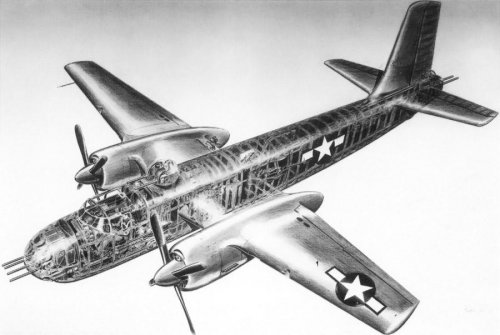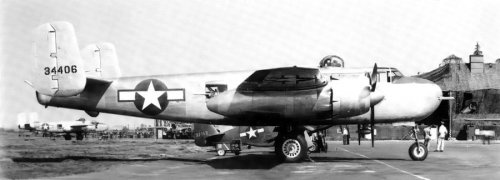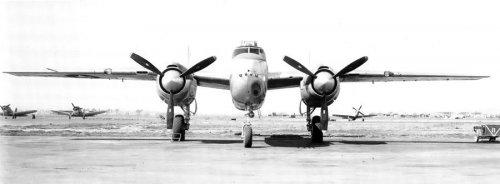- Joined
- 1 May 2007
- Messages
- 2,531
- Reaction score
- 1,740
From the 'Old Machine Press' blog :-
http://oldmachinepress.wordpress.com/2012/09/02/na-98x-super-strafer/
North American Aviation NA-98X 'Super Strafer'
A 1943, North American Aviation (NAA) design for an improved attack bomber that would provide the firepower of the B-25H but with substantially improved performance. This was intended as an alternative to the delayed Douglas A-26B Invader.
Power was to be provided by a pair of Pratt & Whitney R-2800 air-cooled radial engines housed inside low-drag cowlings and driving a pair of four-blade propellers with spinners.
The twin fins were to be replaced by a conventional single-tail, altering one of the B-25’s most notable characteristics. The wing tips were to be square-cut, permitting the ailerons to be extended farther outboard to provide better roll control. Armament improvements were to include a computing gun sight and a new low-drag canopy designed by North American for the top turret. Otherwise, the aircraft had the same armament as the B-25H, including the 75mm cannon.
In early 1944, a less ambitious alternative was submitted to the Army Air Forces. This proposal was to take the existing B-25 airframe and apply many of the enhancements from the improved NAA design. A B-25H-5 (serial number 43-4406) was chosen as a testbed for the modifications, which no longer included the single tail and four-blade propellers. It was given the designation NA-98X by NAA and nicknamed Super Strafer. Since it was not designed for any USAAF requirement, it never carried an official USAAF designation.
The first flight of the NA-98X took place on March 31, 1944, and it was found that the Super Strafer performed well. However,on April 24, 1944, the aircraft suffered a major structural failure and crashed, killing both pilots on board. Following the crash, all further work on the NA-98X project was abandoned even though the RAF had shown interest after a test flight.
See also http://www.secretprojects.co.uk/forum/index.php/topic,242.msg42723.html#msg42723 replies #56 and #'57.
cheers,
Robin.
http://oldmachinepress.wordpress.com/2012/09/02/na-98x-super-strafer/
North American Aviation NA-98X 'Super Strafer'
A 1943, North American Aviation (NAA) design for an improved attack bomber that would provide the firepower of the B-25H but with substantially improved performance. This was intended as an alternative to the delayed Douglas A-26B Invader.
Power was to be provided by a pair of Pratt & Whitney R-2800 air-cooled radial engines housed inside low-drag cowlings and driving a pair of four-blade propellers with spinners.
The twin fins were to be replaced by a conventional single-tail, altering one of the B-25’s most notable characteristics. The wing tips were to be square-cut, permitting the ailerons to be extended farther outboard to provide better roll control. Armament improvements were to include a computing gun sight and a new low-drag canopy designed by North American for the top turret. Otherwise, the aircraft had the same armament as the B-25H, including the 75mm cannon.
In early 1944, a less ambitious alternative was submitted to the Army Air Forces. This proposal was to take the existing B-25 airframe and apply many of the enhancements from the improved NAA design. A B-25H-5 (serial number 43-4406) was chosen as a testbed for the modifications, which no longer included the single tail and four-blade propellers. It was given the designation NA-98X by NAA and nicknamed Super Strafer. Since it was not designed for any USAAF requirement, it never carried an official USAAF designation.
The first flight of the NA-98X took place on March 31, 1944, and it was found that the Super Strafer performed well. However,on April 24, 1944, the aircraft suffered a major structural failure and crashed, killing both pilots on board. Following the crash, all further work on the NA-98X project was abandoned even though the RAF had shown interest after a test flight.
See also http://www.secretprojects.co.uk/forum/index.php/topic,242.msg42723.html#msg42723 replies #56 and #'57.
cheers,
Robin.





